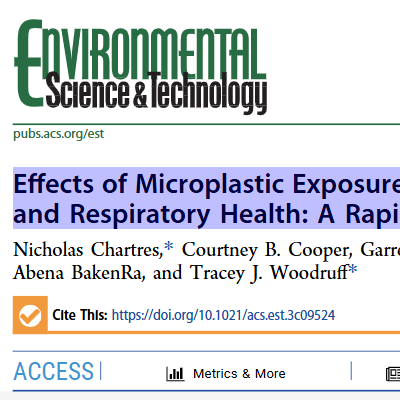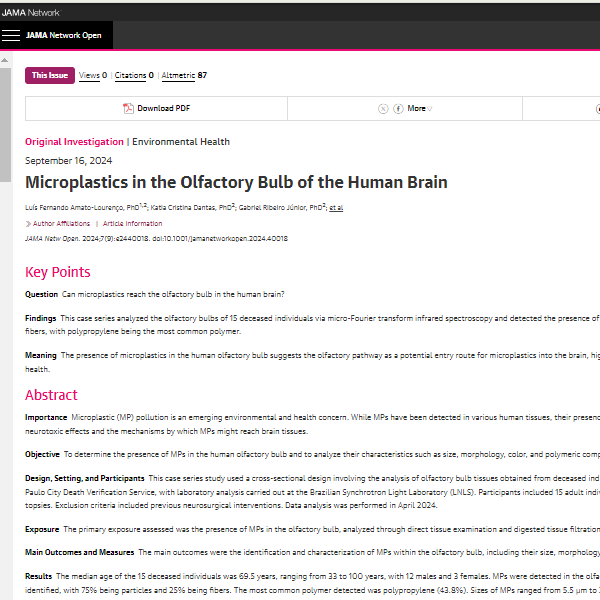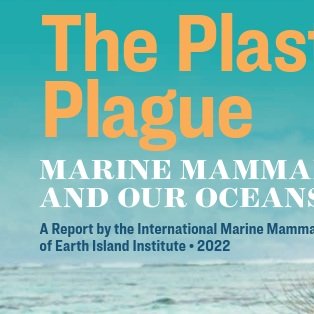
Comparative assessment of microplastic ingestion among deep sea decapods: Distribution analysis in Sardinian and Catalan waters
This study presents, for the first time, a comprehensive evaluation of microplastic ingestion levels in four ecologically and commercially significant crustaceans, spanning two distinct regions in the Mediterranean Sea. By addressing this critical knowledge gap, a consistent methodology was used, enhancing data comparability and providing novel insights into regional and species-specific patterns of microplastic exposure.

Microplastics in the bloodstream can induce cerebral thrombosis by causing cell obstruction and lead to neurobehavioral abnormalities
We show that circulating MPs are phagocytosed and lead these cells to obstruction in the capillaries of the brain cortex. These blockages as thrombus formation cause reduced blood flow and neurological abnormalities in mice. Our data reveal a mechanism by which MPs disrupt tissue function indirectly through regulation of cell obstruction and interference with local blood circulation, rather than direct tissue penetration.

Effects of Microplastic Exposure on Human Digestive, Reproductive, and Respiratory Health: A Rapid Systematic Review
We concluded that exposure to microplastics is “unclassifiable” for birth outcomes and gestational age in humans on the basis of the “low” and “very low” quality of the evidence. We concluded that microplastics are “suspected” to harm human reproductive, digestive, and respiratory health, with a suggested link to colon and lung cancer. Future research on microplastics should investigate additional health outcomes impacted by microplastic exposure and identify strategies to reduce exposure.

Presence of microplastics in human stomachs
This study presents the first definitive confirmation of microplastic presence in the human stomach, based on samples from 26 cadavers. 97 microplastic particles were extracted from stomach contents, across all 26 individuals, revealing a universal prevalence of microplastics in the cadavers.

Association of mixed exposure to microplastics with sperm dysfunction: a multi-site study in China
Our findings highlight the potential reproductive health risks posed by microplastic contamination, particularly PTFE, a non-stick pan coating material, and raise concerns about the potential of urine testing as an indicator of male reproductive microplastic exposure. Future research is warranted to further elucidate the mechanisms underlying the adverse effects of microplastics on male fertility and cross-generational effects.

Microplastics in the Olfactory Bulb of the Human Brain
This case series provides evidence of MPs found in the human olfactory bulb, suggesting a potential pathway for the translocation of MPs to the brain. The findings underscore the need for further research on the health implications of MP exposure, particularly concerning neurotoxicity and the potential for MPs to bypass the blood-brain barrier.

Discovery and analysis of microplastics in human bone marrow
Pyrolysis-gas chromatography-mass spectrometry (Py-GC/MS) is an emerging thermal analysis technique that reliable qualified and quantified data for MPs risk assessment of human health [15], [26]. Laser direct infrared spectroscopy (LD-IR) has been widely used to characterize of MPs, including their type, size, and morphology [12]. This study utilized Py-GC/MS, LD-IR, and scanning electron microscopy (SEM) to analyze and identify the accumulation of MPs in the bone marrow. The results provide crucial data for evaluating the risks of MPs on human haematopoietic injury, and support further studies with larger sample sizes and more detailed designs to explore the health implications of MPs in human bone marrow.

Chemical Recycling: A False Promise for the Ohio River Valley
Ohio River Valley Institute’s July 2024 report explores the many reasons why chemical recycling is a false promise for the region, from hazardous chemicals, to greenhouse gas emissions, the habitat and ecosystem degradation, to the technology’s expense and general lack of success, and more.

Microplastic presence in dog and human testis and its potential association with sperm count and weights of testis and epididymis
Our study revealed the presence of microplastics in all canine and human testes, with significant inter-individual variability. Mean total microplastic levels were 122.63 µg/g in dogs and 328.44 µg/g in humans. Both humans and canines exhibit relatively similar proportions of the major polymer types, with PE being dominant. Furthermore, a negative correlation between specific polymers such as PVC and PET and the normalized weight of the testis was observed. These findings highlight the pervasive presence of microplastics in the male reproductive system in both canine and human testes, with potential consequences on male fertility.

Bioaccumulation of Microplastics in Decedent Human Brains Assessed by Pyrolysis Gas Chromatography-Mass Spectrometry
Rising global concentrations of environmental micro- and nanoplastics (MNPs) drive concerns for human exposure and health outcomes. Applying pyrolysis gas chromatography-mass spectrometry (Py-GC/MS) methods to isolate and quantify MNPs from human samples, we compared MNP accumulation in kidneys, livers, and brains.

Microplastics and Nanoplastics in Atheromas and Cardiovascular Events
Plastic waste is a growing problem, and as plastics break down the pieces can be problematic. A new study in Science Advances suggests that tiny plastic particles may be the latest environmental contributor to Parkinson’s disease (PD)

Plastic Waste Contaminants Could Promote Parkinson’s
Plastic waste is a growing problem, and as plastics break down the pieces can be problematic. A new study in Science Advances suggests that tiny plastic particles may be the latest environmental contributor to Parkinson’s disease (PD)

Identification and analysis of microplastics in human lower limb joints
Our findings demonstrate the presence of MPs in human joints and suggest that further studies are needed to explore the intricate associations between MPs and anatomical location, clinical diagnosis, and local cellular responses.

The Minderoo-Monaco Commission on Plastics and Human Health
The Minderoo-Monaco Commission on Plastics and Human Health has produced an extensive analysis of the plastics’ negative impacts on: i) human health and well-being focusing on vulnerable populations, ii) on the global environment focusing on ocean health, and iii) the economy. The report includes highly valuable sustainable solutions that can be implemented by governments and industries to minimize the negative consequences of global plastic contamination This is an urgent problem that must be addressed in the worldwide agenda in parallel to climate change, as they are closely interconnected.

Detection of Microplastics in Human Saphenous Vein Tissue Using μFtir: A Pilot Study
Microplastics (MPs) are ubiquitous in the environment, in the human food chain, and have been recently detected in blood and lung tissues. To undertake a pilot analysis of MP contamination in human vein tissue samples with respect to their presence (if any), levels, and characteristics of any particles identified. This study analysed digested human saphenous vein tissue samples (n = 5) using μFTIR spectroscopy (size limitation of 5 μm) to detect and characterise any MPs present.

Microplastics Occurrence, Health Effects, and Mitigation Policies: An Evidence Review for the California State Legislature
This report responds to a joint request from the California Senate Committee on Environmental Quality and the Assembly Committee on Natural Resources for evidence concerning human health effects of microplastics and public policies related to microplastics prevention and mitigation.
Research was conducted by the California State Policy Evidence Consortium (CalSPEC), anindependent program administered through the University of California Center Sacramento (UCCS) and composed of faculty, staff, and graduate student researchers across UC campuses who evaluate evidence to inform public policy deliberations.

Field Measurements Reveal Exposure Risk to Microplastic Ingestion by Filter-Feeding Megafauna
Per day, a krill-obligate blue whale may ingest 10 million pieces of microplastic, while a fish-feeding humpback whale likely ingests 200,000 pieces of microplastic. For species struggling to recover from historical whaling alongside other anthropogenic pressures, our findings suggest that the cumulative impacts of multiple stressors require further attention.

The Plastics Plague: Marine Mammals and Our Oceans in Peril
A new report, “The Plastics Plague: Marine Mammals and Our Oceans in Peril,” explores the deadly interactions between marine mammals and plastic, from drowning in plastic nets to ingestion and nervous system damage from plastic toxins.

Raman Microspectroscopy Detection and Characterisation of Microplastics in Human Breastmilk
The evidence of microplastics (MPs) in human breastmilk, coupled with the previous discovery of these microparticles in the human placenta, represents a great concern, since it impacts the extremely vulnerable population of infants. In fact, the chemicals possibly contained in foods, beverages, and personal care products consumed by breastfeeding mothers may be transferred to the offspring, potentially exerting a toxic effect. Hence, it is mandatory to increase efforts in scientific research to deepen the knowledge of the potential health impairment caused by MP internalisation and accumulation, especially in infants, and to assess innovative, useful ways to reduce exposure to these contaminants during pregnancy and lactation.

Plastics in Agriculture – An Environmental Challenge
The Foresight Briefs are published by the United Nations Environment Programme to highlight a hotspot of environmental change, feature an emerging science topic, or discuss a contemporary environmental issue. The public is provided with the opportunity to find out what is happening to their changing environment and the consequences of everyday choices, and to think about future directions for policy. The 29th edition of UNEP’s Foresight Brief explores the use of plastic in agriculture and the significant waste problem this entails which impacts on soil health, biodiversity, productivity and food security.

